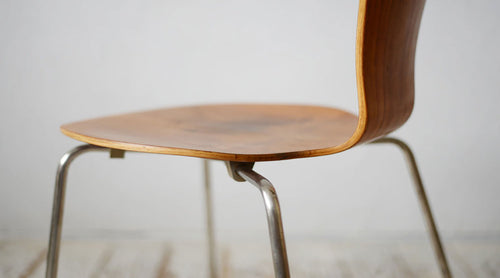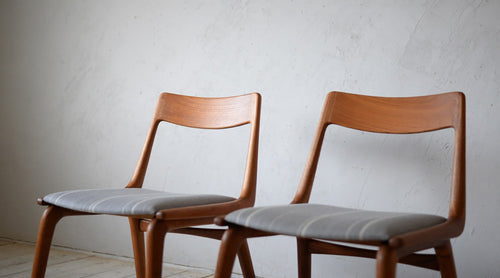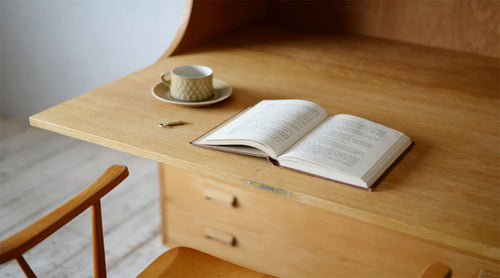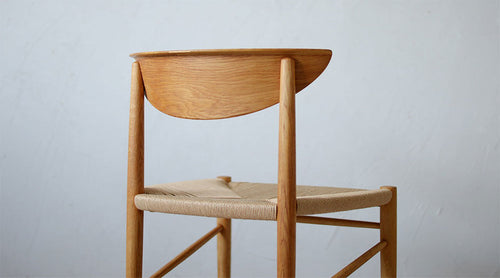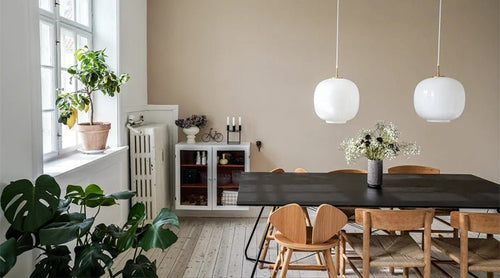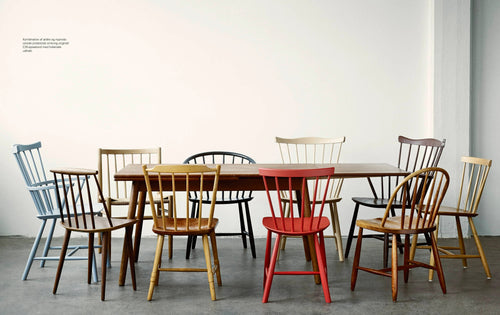Want to know more about the Scandinavian designer Børge Mogensen? Eight stories to get to know Mogensen
Hello everyone. This is Okada from Greenwich.
"Learn More About Nordic Designers" is a series that delves deeply into Nordic-born interior designers from various angles.
This time we will introduce Børge Mogensen, a well-known Danish designer.
Borge Mogensen (1914-1972)

He was born in 1914 in Aalborg, a city in western Denmark.
He studied under Kaare Klint at the Royal Danish Academy of Architects, learning design as his assistant and obtaining his master's degree.
From 1942 he worked as head of planning and design at FDB Möbler (the furniture division of the Danish Co-operative Society).
One of his representative works is the "J39," which has long been affectionately known as "The People's Chair."
This chair is a best-selling chair in Denmark, with an extremely simple and uncluttered design made for the common people.
After retiring from FDB Möbler in 1950, he set up his own office and produced many straight-lined, powerful pieces of furniture that were redesigns of the American Shaker furniture he had developed at FDB Möbler.
When you think of Mogensen, you think of FDB Möbler, and when you think of FDB Möbler, you think of Greenwich...
So, we would like to present to you the charm of this indispensable figure in Greenwich through eight episodes.
Learn more about Mogensen in these eight episodes
1. My dream is to "design low-cost furniture for the common people"

"I want to improve the lives of Danish people with the furniture I design."
The "J39" chair, designed with a strong sense of mission for the common people, has been a huge hit, selling over 800,000 chairs since its release in 1947.
It is said to be the most numerous Danish-made chair in the world.
At first glance, the chair appears simple and rustic, but in order to give it a calming effect, the arrangement of the components and the composition of the surface were carefully designed, demonstrating Mogensen's strong commitment to furniture making.

For example, by adding drawers to storage furniture where none had been there before, we were able to eliminate waste.
And rather than the plush sofas that were common at the time (which Mogensen called a "butcher's sofa!"), he turned the chairs into sofas with soft cushions, so that the covers could be easily replaced if they became worn out.
Mogensen described his proposals for new furniture for the common people as "a personal war against oppressive Danish furniture."
Winning that "war" gave people a better life.
2. "Simple and practical" - a pioneer of modern Danish furniture

When it comes to Danish furniture, many people may imagine it to be "simple, functional, and practical."
But in reality, old Danish furniture was generally large, heavy and extravagantly decorated.
Shortly after the war, Mogensen noticed that people were increasingly moving from rural areas to cities, and many of them were living in small, cramped apartments.
Until then, there was no space to store large, heavy furniture, dressing tables, dining tables, etc. in small apartments, and many people were in trouble.
Mogensen sarcastically describes these pieces of furniture as "fat butcher's furniture" (!).
Mogensen's philosophy is that furniture should be suitable for everyday life and make effective use of space, and that "if it's not useful, throw it away, and if it's not practical, replace it."
For him, furniture was something that "solved everyday problems", so "simple and practical" furniture became the hallmark of his designs. As these designs became widely adopted in Danish life, they also became the hallmark of Danish furniture itself.
3. Cherish and inherit the teachings of Kaare Klint

Mogensen studied under Kaare Klint, a master of Scandinavian design.
We design furniture based on his teachings, such as ergonomics, which states that "furniture should be appropriate for the size of the human body and be functional," and redesign, which states that "knowledge gained from measuring chairs of past styles is used to create new chairs."
This has shaped the consistent characteristics of Mogensen's designs: durability, usability and beauty.
④ Thorough measurement and calculation

When designing a home storage unit, Mogensen takes thorough measurements of every object found in an ordinary household - clothes, cutlery, needlework tools, pipes, writing utensils, folded shirts, racks of hangers, etc.
We calculated how long a rack would be needed for a woman, and how long would a man be, and then designed it.
It's a truly daunting task, but the storage furniture that is produced through this thorough work is very efficient and easy to use, as it can be divided up efficiently and combined in a variety of ways to suit your home.
As a system of storage furniture, it was installed in every home in Denmark.
Why go to such lengths to measure and calculate everything...?
One theory is that his own mind was disorganized and scattered, and he wanted to calm himself by bringing order to the outside world.
His extraordinary attention to order may have led to his unique characteristic of being both functional and beautiful.
5. Known as the "Furniture Monk"

Mogensen always had a stoic attitude towards his work.
He is so absorbed in his work that his wife says, "If you take away his job, he won't be able to survive."
This stoicism may be one of the reasons why he has been able to design so many pieces of furniture (and what's amazing about Mogensen is that he has hardly ever produced a failure).
Mogensen himself saw himself as "just a furniture maker" and was a self-proclaimed "workaholic."
Not only was she dedicated to her work, but the work was also very regimented.
Everything is planned carefully and meticulously, with stories of him partying all night and then going to work early the next morning.
Apparently, he was called the "furniture monk" because of this.
And for Mogensen, his home was his laboratory: he tested his furniture with his family and designed it in a hands-on way.
His thoroughness is evident from the anecdote that he called the place where he conducted his experiments "home."
According to his son, Thomas Mogensen, he once came home to find his room had been emptied without anyone's permission...it may not have been a very comfortable home for the family.
⑥Relationship with Danish furniture designers

He is the same age as Hans J. Wegner, who is famous for the Y Chair, and they are very good friends.
When they were young, they lived in the same apartment, sometimes working together to create products and sometimes competing with each other, and they were apparently very close friends both in private and public life.
Even when they went on a trip together, they didn't go to the beach, but instead spent the time happily measuring furniture together...
On the other hand, he clashed with Verner Panton and Arne Jacobsen due to their different ideas about design.
Together with Arne Carlsen he published an editorial entitled "The Decline of Arts and Crafts", in which he strongly criticised them for their "pretentious style, poor marketing and shallow thinking about design".
Mogensen says he was not interested in "design for design's sake".
Children play on it, young people spill drinks on it, and old people grow old with the furniture...Our ideal was to design furniture that would naturally fit into people's lives.
7. A friendly side and a slightly unconventional personality

Due to his friendly nature, Mogensen was able to form friendships with artists from a variety of genres.
He often invited artists who shared his belief that "hard work is more important than inspiration" to his home (which also served as his laboratory).
On the other hand, he also has a somewhat wild side, such as becoming violent when he drinks too much.
Only once in my life did I drink and drive a car, get caught by the police, and go to prison for two months.
But as you'd expect, Mogensen is always thinking about furniture, no matter the situation.
Using the notebook and pencils he was given inside the prison, he sketched out ideas inspired by the prison space.
This later became a huge hit as furniture for nursing homes.
Andreas Kluversen, founder of Fredericia Furniture and a working collaborator with Mogensen, said of him "he had a unique talent for rising out of the depths of despair."
He is a friendly, eccentric, and indomitable man...perhaps part of his charm lies in his personality.
8. Even luxury items are "modest"

During the 1960s, a long period of economic boom led Danish people to seek luxury goods rather than everyday items.
Mogensen, who has always created products that are close to people, will add a new element of "luxury" to his designs to meet their needs.
However, it was by no means excessively extravagant or gaudy, but rather modest and just the right amount of luxury -- in other words, "modest luxury."
Towards the end of the 1950s, Spain was all the rage in Europe.
Mogensen also traveled to Spain with his family and, like Hemingway, watched bullfights and even grew a beard in his imitation.
The Spanish Chair was designed based on inspiration from the officers' chairs and the cave paintings in Lascaux that he encountered during that trip.
Although it is a little different from Mogensen's previous furniture, with its wide armrests and thick leather, making it a ``luxurious'' piece, the design is actually very simple.
It has a simple construction consisting of two pieces of leather and 12 dowels, with no hidden parts and each individual component refined.
It is luxurious yet understated, and you can really feel the sincerity that is so characteristic of Mogensen.
This is truly a chair that can be described as "modest luxury."
What did you think of the eight stories about Mogensen?
Highly recommended for those who want to know more.
The documentary film Borge Mogensen "DESIGN FOR LIFE", which gives a glimpse into the real Mogensen, is also available on DVD with Japanese subtitles .
What is Mogensen's design philosophy? Who is he?
The 58-minute documentary is well worth watching.
Please take a look at this as well.
Greenwich Okada

About
この記事をかいた人
岡田 智理
グリニッチ広報・企画担当。
インテリアコーディネーター資格、住空間収納プランナー資格を所有。
ブログや企画イベントを通して、暮らしを満たすヒントや、グリニッチが提案するさまざまな価値について、明るく楽しくお伝えしていきます。

